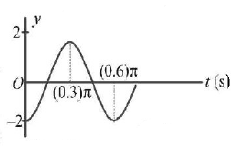Question
Part of a simple harmonic motion is graphed in the figure, where $$y$$ is the displacement from the mean position. The correct equation describing this $$S.H.M.$$ is
Part of a simple harmonic motion is graphed in the figure, where $$y$$ is the displacement from the mean position. The correct equation describing this $$S.H.M.$$ is

A.
$$y = 4\cos \left( {0.6t} \right)$$
B.
$$y = 2\sin \left( {\frac{{10}}{3}t - \frac{\pi }{2}} \right)$$
C.
$$y = 4\sin \left( {\frac{{10}}{3}t + \frac{\pi }{2}} \right)$$
D.
$$y = 2\cos \left( {\frac{{10}}{3}t + \frac{\pi }{2}} \right)$$
Answer :
$$y = 2\sin \left( {\frac{{10}}{3}t - \frac{\pi }{2}} \right)$$
Solution :
$$\eqalign{ & {\text{From}}\,{\text{the}}\,{\text{figure,}}\,\,\frac{T}{2} = 0.3\pi , \cr & \therefore T = 0.6\,\pi \,\,{\text{and}}\,\,{\phi _0} = - \frac{\pi }{2}. \cr & {\text{Thus}}\,\,y = A\sin \left( {\omega t + {\phi _0}} \right) = 2\sin \left\{ {\frac{{2\pi }}{{0.6\pi }}t + \left( { - \frac{\pi }{2}} \right)} \right\} \cr & = 2\sin \left( {\frac{{10t}}{3} - \frac{\pi }{2}} \right). \cr} $$
$$\eqalign{ & {\text{From}}\,{\text{the}}\,{\text{figure,}}\,\,\frac{T}{2} = 0.3\pi , \cr & \therefore T = 0.6\,\pi \,\,{\text{and}}\,\,{\phi _0} = - \frac{\pi }{2}. \cr & {\text{Thus}}\,\,y = A\sin \left( {\omega t + {\phi _0}} \right) = 2\sin \left\{ {\frac{{2\pi }}{{0.6\pi }}t + \left( { - \frac{\pi }{2}} \right)} \right\} \cr & = 2\sin \left( {\frac{{10t}}{3} - \frac{\pi }{2}} \right). \cr} $$